Walls of Hope and The Perquin Model
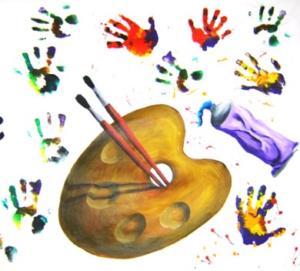
Vision
Walls of Hope is an international art and human rights project of art, education, conflict resolution, crime prevention, diplomacy building, community development and preservation of historic memory.
Started in 2005, Walls of Hope facilitates, implements, and teaches art to children, youth, adults, and the elderly. The Perquin Model is a blueprint that has become a replicable art model implanted successfully in many regions in El Salvador, as well as in Guatemala, México, Argentina, Canadá, Switzerland, Germany, Northern Ireland, and the United States. In 2016, Walls of Hope, born in a war zone in El Salvador, moved to Sincelejo, Colombia, to join the efforts of the Colombian Peace Process by using the strategies of art and the practice of communal building in the arduous task of recovery of a country that suffered a 52 year-long civil war.
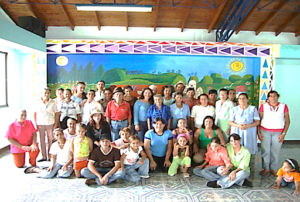 Asociación de Víctimas de Violencia de Cocorná, Antioquia, Colombia
Asociación de Víctimas de Violencia de Cocorná, Antioquia, Colombia
Association of Victims of Violence from Cocorná, Antioquia, Colombia, August 2009
Mission
The community art projects created in the Perquin Model focus on the challenges posed by inter-communal and societal conflicts in today’s world. Our mission is to bring greater awareness through shared town meetings and through the planning of collaborative art interventions and public art pieces. The collaborative art projects recover historic memory while providing artistic skills and practical expertise in a new model of art education. The mandate of our school is to create bridges of collaboration with local and political agencies that will welcome art as a contribution of social planning, to develop leadership roles among the participants, especially the youth who will face the challenge to grow up in a collapsed economic scenario threatened by poverty and unemployment. Through art and creative praxis, children and youth focus on conflict resolution envisioning a proposition for endurable peace.
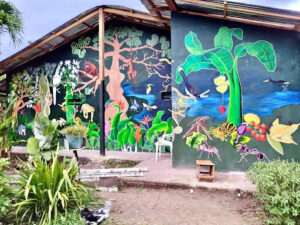
History
The School of Art and Open Studio of Perquin/ Walls of Hope was started in 2005 in El Salvador.
Four Salvadoran artists/ teachers direct the school: America Argentina Vaquerano Romero, Claudia Verenice Flores Escolero, Rosa del Carmen Argueta, working in collaboration with Claudia Bernardi, founder, artist, and educator from Argentina.
As part of the Peace Accords signed in 1992 ending twelve years of civil war in El Salvador, the United Nations Truth Commission nominated the Argentine Forensic Anthropology Team, Equipo Argentino de Antropología Forense, EAAF, to perform the exhumations of the massacre at El Mozote, Morazán. Rufina Amaya Márquez, the sole survivor of the massacre, stated that the Salvadoran army murdered more than 1000 civilians on December 11th, 1981.
The Argentine Forensic Anthropology Team, EAAF asked Claudia Benardi, artist and educator from Argentina who founded the Perquin Model, to create the archeological maps that would record the location and finding of human remains, associated objects and the presence of ballistic evidence. After three months of investigation, the allegation of mass murder against civilian population was confirmed including 136 children under the age of 12.
Bernardi states, “Once my assignment as consultant/ cartographer in the case of the investigation of the massacre at El Mozote concluded, I went to Perquin, a village of 5,000 inhabitants located 4 km. North from where the hamlet of El Mozote once existed. Perquin had been hugely impacted by the war. The people living there in 1992 were ex combatants or civilians who had recently returned from a refugee camp in Honduras. The majority of the existent houses were unhabitable. As I looked around amazed at the effects of destruction. I was surrounded with evidence of pain contained on the wounded walls. They were walls of pain. “How?” I wondered, “Could they ever turn into Walls of Hope?”
“Since 1992 until 2005, I visited Perquin frequently. It was during those visits to Morazán and to Perquin that I learned about the history of violence inflicted to civilian population during the 12 years civil war, forced displacements of families who had suffered the death of many family members, and the loss of their crops. They felt overwhelmed by tragedy and were afraid for not retaining historic memory.”
The creation of Walls of Hope responds to the following question:
“ How can the insertion of art be constant in the life of a community?”
The proposal of community building through artistic expression of wall murals implies the creation of a reality that has not previously existed. In this newness, perhaps, is where the kernel of life resides.””
The Perquin model has been replicated in other countries, responding to the needs of communities. (See below: “Selected Collaborative and Community-based Projects, 2007-2022”)
The project continues with funding from non-profit and for-profit organizations, individuals, and grants.
Activities
The activities that expand from Walls of Hope focus upon designing, creating, and completing community-based and collaborative art projects. These use the strategies of various arts to rebuild a torn apart region where the legacy of wars and political violence is followed by social, institutional, and economic collapse.
Walls of Hope welcomes everyone, all members of the community of all ages regardless of their political or religious affiliation. The focus is the creation of :
-
- collaborative murals
- public art projects
- urban interventions such as collaborative environmental art projects that include garbage separation and collection, water safety, urban planning towards identifying safe spaces of congregation for children and youth, and others.
- weekly classes and workshops of painting, drawing, wood sculpture, furniture making mask making, textile art and printmaking
- weekly workshops focusing on recycled materials and the respect and preservation of the environment
Community members decide what, where, and how to do their project. They are given opportunity to share their histories and traumas as they design and develop the project.
International artists are invited to share with the community their skills and artistry producing week -long workshops designed to teach and disseminate techniques, skills, and innovative aesthetic propositions. Community members are also trained to facilitate art classes. Since 2015 there have been weekly courses addressing the urgent need to recuperation and respect the environment, using exclusively recycled materials. The four artists/ teachers of Walls of Hope facilitate, implement, and teach children, youth, adults, and the elderly bridging art beyond El Salvador.
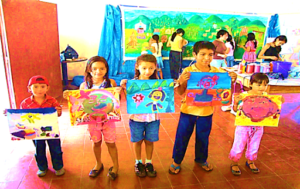 Baja Verapaz, Guatemala, 2009
Baja Verapaz, Guatemala, 2009
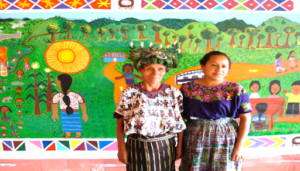 Perquin, El Salvador, 2011
Perquin, El Salvador, 2011
EL MURAL, Mural colaborativo en el edificio de la ex-ESMA
https://www.youtube.com › watch
Preview
3:50
Facilitadores EAAF: Patricia Bernardi, Viviana D’ Amelia, Nuri Quinteiro, Carlos Rojas Surraco y Marcelo Castillo. Directora artística: Claudia …YouTube · ROCCOMOTION · Apr 5, 2014
Audiences Served
Walls of Hope designs, facilitates, and complete collaborative and community-based art projects for children, youth, adults, and the elderly regardless of their political or religious affiliation.
The project exists in the intersection of art and political violence focusing on the pursuit and respect of human rights and social justice. The communities of people that Walls of Hope serves are survivors of massacres, survivors of torture, victims of forced exiles, asylum seekers, indigenous people, Pueblos Originarios, and incarcerated youth in the United States.
Members of the community are trained to facilitate the various art classes, which continue after the project is complete.
Successful Impact: The Perquin Model
The Perquin Model is a blueprint that has become a replicable art model implanted successfully in many regions in El Salvador, as well as in Guatemala, México, Argentina, Canadá, Switzerland, Germany, Northern Ireland, and the United States.
The Perquin Model could be defined as follows:
-
- A community-based project that engages children, youth, and adults in the creation of art that serves as a component of community building.
- A project created with the understanding that there has been trauma, violence and prejudice inflicted to the participants through political duress, state terror, wars, and armed conflicts.
- The participants decide on the theme and narration of each piece with the intention to produce a visual testimony that represents their recent history.
- A collaborative art project that expands from creativity towards diplomacy, judicial concerns, anthe demand for the respect for social and human rights.
-
 Children painting a mural at the massacre place of El Mozote
Children painting a mural at the massacre place of El Mozote
The Perquin Model :Selected Collaborative and Community-based Projects, 2007-202
2007, Antigua, Guatemala Mural created by indigenous people, survivors of massacres in Ixcan, Ixil,Nebaj,Chimaltenango and Chaju
2007, Sacramento, California, United States Mural and Video Documentary created by African American and Latino students at Sacramento High School.
2008, Guatemala City. Mural created by 35 indigenous survivors of massacres in Ixcán and Quiché working in collaboration with 15 Human Rights activist and 15 psychosocial workers members of ECAP, Equipo Comunitario de Acción Psicosocial, Community Psychosocial Action Team
2008, Toronto, Canada Walls of Hope: Installation: Sculptures, Paintings, Video, Dance, Theatre, Poetry created by 47 youth at risk, recent refugees and asylum seekers and youth living with special needs.
2008, Huehuetenango, Guatemala Mural created by 35 indigenous women survivors of sexual violence during the armed conflict
2009, Cobán, Guatemala Workshop of Modeled paper sculptures created by 35 indigenous women survivors of sexual violence and sexual slavery during the armed conflict.
2009, Rabinal, Guatemala Mural created by 52 indigenous survivors of torture, and survivors of the massacres of Rabinal, Plan de Sánchez and Río Negro, Baja Verapaz
2009, Cocorná, Colombia Mural created by 59 members of AVVIC, Asociación de Víctimas de Violencia de Cocorná, Association of Victims of Violence and Forced Displacement of Cocorná, Antioquia.
2010, Panzós, Guatemala Mural created by 75 men, women, youth, and children survivors of the massacre of Panzos, Alta Verapaz.
2010/2011 Perquin, El Salvador Collaborative and community mural created by 30 women affiliated with ACMM/ Asociación Comunitaria de Mujeres de Morazán, Women’s Community Association of Morazán and 20 students and faculty from Mary Baldwin University, Virginia, United States
2011, Belfast, Northern Ireland Collaborative and community mural created by 95 Catholic and Protestant children on Ardoyne Road, West Belfast during the Ardoyne district riots.
2011, Permeable Borders/ Waynesboro, Virginia, United States Collaborative and community mural created by 75 children from Winona Elementary School, 20 children from Central America at Casa la Amistad and students and teachers from Mary Baldwin University
2012, Le Mur de l’Espoir, Monthey, Switzerland Mural created in collaboration with Amnesty International that brought together 93 refugees, migrants, asylum seekers, and victims of forced exiles from Latin America, Africa and Eastern Europe.
2013, Staunton, Virginia, United States Mural created at the Booker T. Washington Community Center by 42 African-American elders in collaboration with 20 students and faculty at Mary Baldwin University.
2013, Ciudad Juarez, Mexico Mural created by 26 young people, aged 13 to 17, survivors of violence caused as a result of Mexico’s drug wars in the state of Chihuahua, Mexico.
2013, University of Osnabrük, Osnabrük, Germany Mural created by 25 Social Work students and 45 migrant women from Eastern Europe, Africa, Latin America, and the Balkans.
2013, Le Mur de l’Espoir, Fribourg, Switzerland Mural created in collaboration with Amnesty International that brought together 35 refugees, political asylum seekers, and forced exiles from Afghanistan, Congo, Sri Lanka, Eritrea, Somalia and Tibet.
2013, Ciudad Juarez, Mexico Modeled paper sculptures created by 25 young people, ages 13 to 17, survivors of violence caused as a result of Mexico’s drug wars, in the state of Chihuahua, Mexico.
2014, Buenos Aires, Argentina The Disappeared are Appearing, collaborative and community-based mural created by 57 relatives of disappeared people, who were able to recover the human remains of their loved ones through the work of the Argentine Forensic Anthropology Team. The mural was painted in the Former Clandestine Detention and Extermination Center, ESMA
2014, Labyrinths on the Border / The Train of Dreams, Virginia, United States Collaborative mural created by 40 undocumented, unaccompanied, Central American migrant minors detained in juvenile centers in the United States.
2014, Buenos Aires, Argentina “How Do You Draw Truth?” Collaborative and community-based mural created by 35 relatives of victims of police brutality in Argentina. Museo de Arte de la Memoria, Comisión Provincial por la Memoria de la Provincia de Buenos Aires CPM/ Museo de Arte y Memoria de la Provincia de Buenos Aires, La Plata, Buenos Aires, Argentina.
2014, Buenos Aires, Argentina “El Nudo/ The Knot” Collaborative and community-based mural painted by 45 human rights activists, relatives of the disappeared, and staff of the Ex ESMA, Former Clandestine Center of Detention, Torture and Extermination.
2015, “The Tree of Life,” Collaborative and community-based mural painted by 28 unaccompanied, undocumented, Central American migrant minors incarcerated in a maximum-security facility in the United States.
2016 “Second Chances,” Collaborative and community-based mural painted by 56 unaccompanied, undocumented Central American migrant minors incarcerated in a maximum-security facility in the United States.
2016, Klamath, California, United States Collaborative and community-based mural created by 45 children, youth and adult members of the Yurok Tribe in the Klamath River region of Northern California, Yurok Tribe Courthouse, Yurok Tribe Reservation.2017, Center for Social and Global Engagement, Mary Baldwin University, Staunton, Virginia
“Convivio” Collaborative and community-based mural created by Walls of Hope artists collaborating with students of Mary Baldwin University
2017, “Let Me Flourish Once Again”, Collaborative and community-based mural project created by undocumented, Central American migrant minors, incarcerated in a maximum-security detention center in the United States.
2017, Sucre, Colombia.” The Hard Task of Remembering”, Collaborative and community-based mural created by Walls of Hope artists expanding “The Perquin Model” working with survivors of the massacre of La Libertad, Sucre, Colombia, as part of the proposed Peace Accords and community building through art.
2017, Sucre, Colombia” Finding the Way to Peace” Collaborative and community-based mural created by Walls of Hope artists expanding “The Perquin Model” working with displaced victims and victims of forced exiles from Mampujan, Sucre, Colombia, as part of the Peace Accords
2017, “Building Bridges from Our Origins,” Collaborative and community-based mural developed and created by James Madison University students, DACA students, and undocumented migrant high school students from Harrisonburg, Virginia
2018, “Life Has More Than What I Can See Now,” Collaborative and community-based mural painted by undocumented, incarcerated Central American migrant minors, in a maximum-security detention center in the United States.
2018, Montes de Maria, Colombia “What We Don’t Want to Remember”, Collaborative and community mural created by Walls of Hope artists expanding “The Perquin Model” working with displaced victims, victims of forced exiles from Montes de María, as part of the Peace Accords
2018, Klamath, California, United States Collaborative, community mural created by children, youth, and adult members of the Yurok Tribe in the Klamath River region of Northern California.
2019, “Paths Taken and Others to Take”, Collaborative and community-based mural project created by Central American migrant minors, undocumented, incarcerated in a maximum-security detention center in the United States.
2019, Colosó, Colombia, Collaborative and community-based mural painted by ex-combatants of the FARC, Revolutionary Armed Forces of Colombia, and civilian victims of violence during the 52 yearlong civil war and armed conflict.
2020, “Silhouettes That Talk” Collaborative and community-based mural project created by, , undocumented, incarcerated Central American migrant minors detained in a maximum-security detention center in the United States, using the zoom platform during the COVID pandemic
2021, “Voices From the Pandemic”, Collaborative and community mural project created by, undocumented, Central American migrant minors incarcerated in a maximum-security detention center in the United States, using the zoom platform during the COVID pandemic
2021/ 2022, Tegucigalpa, Honduras” El Modelo Perquin Llega a Honduras/ The Perquin Model Arrives to Honduras”, Collaborative and community-based art project focusing on murals, wood sculpture workshops and art created with recycled materials, facilitated by Walls of Hope artists and Youth Against Violence in Honduras.
Recommendations for replication and/or adaptation
The collaborative art model can be used in a variety of situations involving trauma and/or conflict for groups who wish to preserve and learn from shared memory. If a school district or community wants to adapt the Perquin model, they may utilize the following suggestions.
-
- Hold town or school meetings (or series of meetings) to assess need and plan collaborative art interventions and public art pieces.
- Invite/include participants of different political and religious affiliation.
- Community to host the site for the project and provide materials for the workshops.
- Select exterior or interior walls for an upcoming mural considering the impact it will have in a public space.
- Provide artistic skills and practical experiences in a variety of art forms
- Develop leadership roles among the participants
- Provide opportunities for group discussion
- Focus on conflict resolution
- Take decisions by consensus
- Have a recognition and celebration event upon project completion
- Provide opportunity for evaluation
Art School Heals Guerilla Town’s Wounds (WALLS OF HOPE)
www.youtube.com › watch
https://www.youtube.com/watch?v=dSuYfSSpm_4
4:52
Josué Rojas http://ceibaamericas.blogspot.com Walls of Hope The Art of Art in the Community of Perquin …YouTube · Josue Rojas · Sep 7, 2012
 Rabinal, February, 2009
Rabinal, February, 2009
Contact Information
Claudia Bernardi
510-653-5481
wallsofhope@gmail.com
www.wallsofhope.org
Facebook: Wallsofhope Perquin
